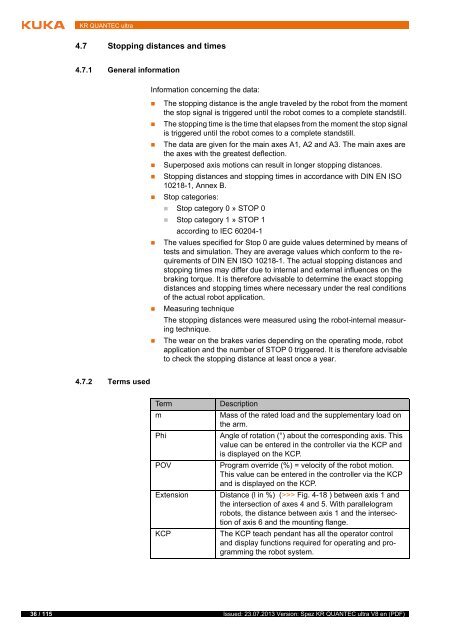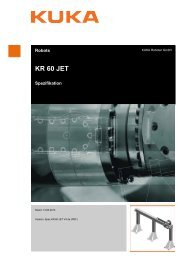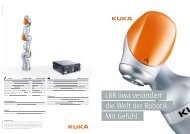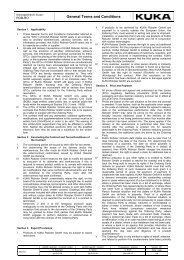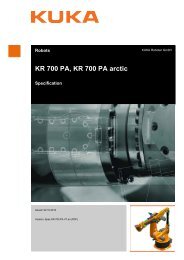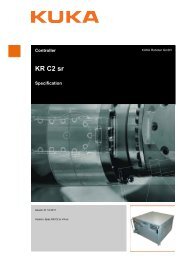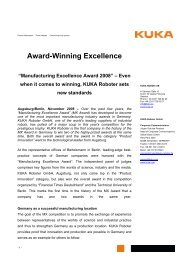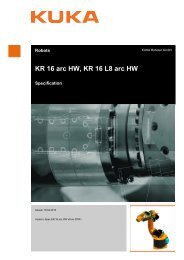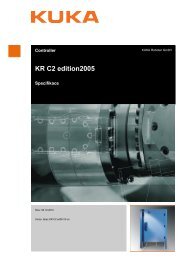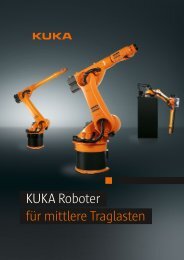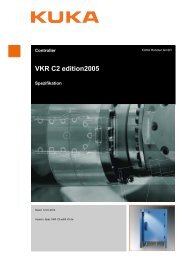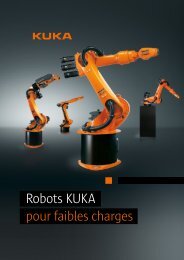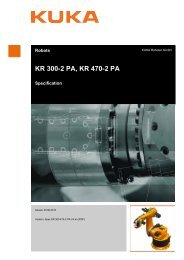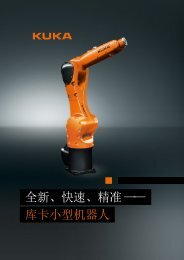KR QUANTEC ultra - KUKA Robotics
KR QUANTEC ultra - KUKA Robotics
KR QUANTEC ultra - KUKA Robotics
Create successful ePaper yourself
Turn your PDF publications into a flip-book with our unique Google optimized e-Paper software.
<strong>KR</strong> <strong>QUANTEC</strong> <strong>ultra</strong><br />
4.7 Stopping distances and times<br />
4.7.1 General information<br />
Information concerning the data:<br />
• The stopping distance is the angle traveled by the robot from the moment<br />
the stop signal is triggered until the robot comes to a complete standstill.<br />
• The stopping time is the time that elapses from the moment the stop signal<br />
is triggered until the robot comes to a complete standstill.<br />
• The data are given for the main axes A1, A2 and A3. The main axes are<br />
the axes with the greatest deflection.<br />
• Superposed axis motions can result in longer stopping distances.<br />
• Stopping distances and stopping times in accordance with DIN EN ISO<br />
10218-1, Annex B.<br />
• Stop categories:<br />
• Stop category 0 » STOP 0<br />
• Stop category 1 » STOP 1<br />
according to IEC 60204-1<br />
• The values specified for Stop 0 are guide values determined by means of<br />
tests and simulation. They are average values which conform to the requirements<br />
of DIN EN ISO 10218-1. The actual stopping distances and<br />
stopping times may differ due to internal and external influences on the<br />
braking torque. It is therefore advisable to determine the exact stopping<br />
distances and stopping times where necessary under the real conditions<br />
of the actual robot application.<br />
• Measuring technique<br />
The stopping distances were measured using the robot-internal measuring<br />
technique.<br />
• The wear on the brakes varies depending on the operating mode, robot<br />
application and the number of STOP 0 triggered. It is therefore advisable<br />
to check the stopping distance at least once a year.<br />
4.7.2 Terms used<br />
Term<br />
m<br />
Phi<br />
POV<br />
Extension<br />
KCP<br />
Description<br />
Mass of the rated load and the supplementary load on<br />
the arm.<br />
Angle of rotation (°) about the corresponding axis. This<br />
value can be entered in the controller via the KCP and<br />
is displayed on the KCP.<br />
Program override (%) = velocity of the robot motion.<br />
This value can be entered in the controller via the KCP<br />
and is displayed on the KCP.<br />
Distance (l in %) (>>> Fig. 4-18 ) between axis 1 and<br />
the intersection of axes 4 and 5. With parallelogram<br />
robots, the distance between axis 1 and the intersection<br />
of axis 6 and the mounting flange.<br />
The KCP teach pendant has all the operator control<br />
and display functions required for operating and programming<br />
the robot system.<br />
36 / 115 Issued: 23.07.2013 Version: Spez <strong>KR</strong> <strong>QUANTEC</strong> <strong>ultra</strong> V8 en (PDF)


